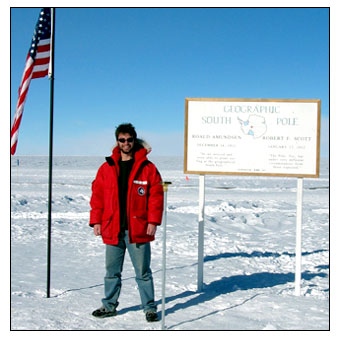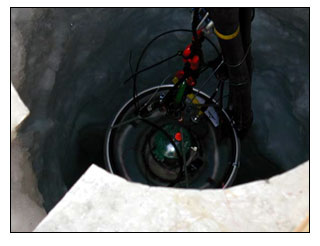RIVER FALLS, Wisc., Dec. 30 -- College students are often known to head south during breaks. Jonathan Eisch took that to the extreme this year when he left wintry Wisconsin for frozen Antarctica. The University of Wisconsin-River Falls (UW-RF) physics major is spending his Christmas vacation at the South Pole, until Jan. 6, with a team of international scientists in the aptly named IceCube Project.
The project involves using a telescope, buried a mile deep in the Antarctic ice, to measure and map the path of neutrinos, the smallest known particles of matter, as they careen from space above the Northern Hemisphere through the earth to the South Pole.

CHILLING: Jonathan Eisch at the South Pole. The sign marks the geographic center of the pole.
Work on the $250 million observatory, known as IceCube and funded by the National Science Foundation, began about two years ago and is scheduled to be finished in 2008.
The telescope, to measure one cubic kilometer, will be made up of 4800 basketball-sized optical sensors strung like beads on 80 fiber optic and electrical cables dropped deep into the ice. The device will work like a reverse light bulb, capturing the little cones of blue light known as muons emitted by neutrinos when they collide with other subatomic particles in the ice.
Eisch said he chose to attend UW-River Falls precisely because it was a partner in the telescope project. His experience with similar functioning tanks in the UW-RF physics lab will enable him to perform his duty at the South Pole observatory, monitoring the freeze of water in two prototype detectors on the surface of the South Pole station. Eisch underwent training with the instruments at the Bartol Research Institute in Delaware.
"This has never been done before at the pole, so I will have to be ready for anything that could go wrong," he said in a university press release.

DEEP FREEZE: Optical modules are strung on electrical cables like beads on a string and frozen more than 1500 meters below the surface of the ice. (Photo: Robert G. Stokstad/NSF. This material is based on work supported by the National Science Foundation under Grant Nos. OPP-9980474 [AMANDA] and OPP-0236449 [IceCube], University of Wisconsin-Madison.)
Encompassing a cubic kilometer of ice, IceCube will provide a novel viewpoint on the multimessenger astronomy of the most violent astrophysical sources. The telescope is a powerful tool to search for dark matter and could reveal the new physical processes associated with the enigmatic origin of the highest energy particles in nature, UW-RF said.
"It's about where we come from and about doing paleontology about as far back in time as you can do it," UW-Madison spokesman Terry Devitt said in an Associated Press article.
In the last decade, an international collaboration of scientists constructed and operated the first high-energy neutrino telescope, called the Antarctic Muon and Neutrino Detector Array, or AMANDA. AMANDA was installed in a remote polar icecap of the Antarctic.
Through the use of about 750 optical sensors, the AMANDA can detect faint flashes of light from subatomic particles -- neutrinos -- through the transparent ice. The unique interactions of neutrinos with matter make them valuable as astronomical messengers. AMANDA has demonstrated the viability of a neutrino telescope in ice by detecting neutrinos produced in the earth's atmosphere as far away as the North Pole.
The history of astronomy shows that work in new energy has invariably resulted in the discovery of totally unexpected phenomena, the university said. Eisch said he is excited to be one of the first people to peer through this "new window" into the universe.
"We can tell what direction the neutrino was going by seeing what the muon does," Eisch told the AP. "What's very nice about the ice at the South Pole is that it's optically clear and very stable. There's nothing living in it, and it moves only very slowly because it's a glacier."
Earlier versions of subatomic particle telescopes built by other researchers have been implanted in the ocean and deep into flooded mines. But Devitt said they have been less effective because they are smaller than IceCube will be and because the water with its currents and life forms does not allow the neutrino collisions to be captured as well as the ice.
UW-Madison leads an international collaboration of 20 institutions in the IceCube project, including UW-River Falls, and colleges in Japan, Germany and Belgium.
For more information, visit: icecube.wisc.edu